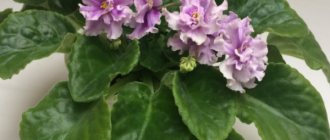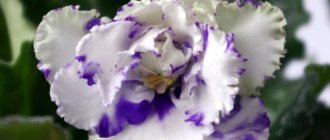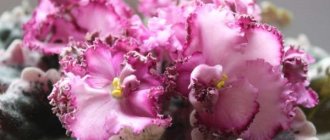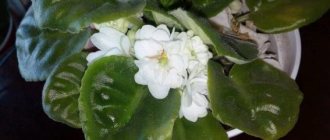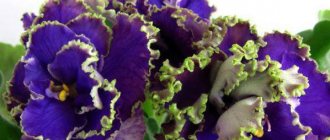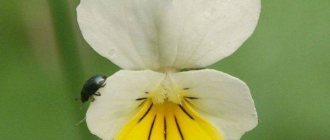A plant similar to the common European violet was discovered during one of the walks in the local mountains by the German governor in the East African region, Baron named Saint-Paul.
By the end of the 19th century, Saintpaulia appeared in Germany and, subsequently, throughout Europe.
In our country, the Uzambara violet begins to be bred within a couple of decades , although it grows mainly in botanical gardens. The selection of Saintpaulias in the USSR began in the mid-20th century.
Violet RM-Circus Princess (N. Skornyakova)
Unusual violet Circus Princess.
The variety RM-Circus Princess belongs to the genus Violet Uzambarskaya, which is part of the botanical family Gesneriaceae of the order Clear-flowered. The botanical name of this genus is Saintpaulia.
History of the variety
The author of the variety RM-Circus Princess, Kursk breeder is Natalya Skornyakova . Natalia's varieties and seedlings are distinguished by their delicate color, often double, with light or bright green foliage.
Photo and description of sotra
Saintpaulia RM-Circus Princess blooms with large semi-double or double multi-layered flowers. Soft pink prints and blue fantasy pattern of strokes and segments.
It has a standard, even rosette made up of medium green leaves. The variety is characterized by abundant cap flowering.
Description
What is the Lady Hamilton violet? Let's start with a brief description of this delicate and exquisite home flower. This variety has a neat rosette and large flowers (reach 5-6 centimeters).
Lady Hamilton violet has a round flower shape. Type of petals: double and semi-double. The coloring is of interest. Delicate light pink flowers with a lilac-raspberry border look very impressive.
Caring for a plant at home
Uzambara violets are often found in :
- Apartments;
- And offices.
Caring for such plants is not difficult, you just need to strictly follow agricultural technology .
Conditions of detention
In order for the Circus Princess to bloom brightly and for a long time, and delight her with green foliage, you need to provide her with :
- Optimal conditions;
- And good care.
For good flowering, the variety requires proper care.
Proper watering and fertilizing
Violets are watered only when the top layer of the substrate is dry. The frequency of watering and the speed of soil drying depend on many factors :
- Violet age;
- Socket size;
- Composition and properties of soil.
To optimize care, all violets in the collection should be planted in the same soil . Water for irrigation needs to be at room temperature, standing for several hours.
ADVICE! It is convenient to water violets with a watering can with a thin long spout or a large medical syringe. They try to pour water onto the border of the substrate at the edge of the pot, so that drops do not remain on the petioles and the growing point.
Violets are fed based on the following important points:
- Saintpaulias need nitrogen when the plant quickly gains green mass, that is, during the period from transplanting to flowering;
- Phosphorus and potassium help to lay a lot of buds and bloom profusely for a long time, so they are added in spring and summer;
- Microelements strengthen the plant’s immunity and resistance to adverse factors;
- Remember that replanting is often more beneficial for a plant than a series of fertilizing.
many forms of fertilizers available commercially :
- Granules;
- Sticks;
- Powders;
- Liquids.
When choosing nutrition for violets, give preference to liquid forms containing chelated compounds of nutrients.
Lighting and temperature
RM-Circus Princess, like most Saintpaulias, prefers bright, diffused sunlight . The optimal location is eastern or western window sills.
In winter, Saintpaulias require additional lighting.
Daylight hours for Saintpaulias should be at least 10 hours . If the lighting is not enough, use a phytolamp; if the light is too bright, the plants will be shaded.
ATTENTION! Lack of light affects the shape of the outlet. Without the sun, it becomes loose and spreading due to elongated petioles.
Air humidity
Humidity is very important for Uzambara violets :
- Soils;
- And air.
These plants are more comfortable if the air humidity is 50-60%:
- An adult Saintpaulia, with good lighting and proper watering, can bloom in drier air;
- For children and rooted petioles, a higher humidity level is needed - about 70%.
What kind of soil does he prefer?
High-moor peat must be included in mixtures for planting violets . Most often, store-bought planting mixtures are not suitable for these flowers, since they contain low-lying peat with an acidic environment.
The soil mixture for Saintpaulia should have the following properties :
- Be moisture-intensive;
- Be light, breathable;
- Contain macro and microelements, without excess nitrogen;
- Weak acid reaction;
- Free from pests and pathogens.
Soil for violets can be bought at a flower shop.
When making up a soil mixture for planting violets, you can follow two approaches :
- A two-component mixture is prepared from high-moor peat with the addition of cultivators (vermiculite, perlite, charcoal). Growing in such a substrate requires frequent feeding;
- A complex mixture is prepared , balanced in chemical composition. Violets planted in such a mixture do not need to be fed.
Pruning and hygiene
The rosette of an adult Saintpaulia is formed to increase decorativeness. Formation rules :
- A regular rosette is formed by 3-4 tiers of leaves;
- The leaf blades should be arranged like tiles on a roof, only partially overlapping each other;
- Leaves of lower tiers are removed;
- Empty flower stalks, diseased, damaged leaves are cut off.
Saintpaulias have axillary flower stalks, so without a healthy, properly formed rosette of leaves, there will be no active flowering .
ADVICE! By removing the lower leaves as the rosette grows, we expose the stem of the violet and the plant becomes unsightly. If this happens to your Isabella, sprinkle the stem with soil, or replant the plant with a fresh one.
The leaves of violets are covered with thin fibers, dust accumulates between them :
- Spoiling the appearance;
- Impairing gas exchange.
Contrary to general opinion, violets can and should be given a hygienic shower . Before the procedure:
- Cover the soil with film;
- Then, gently rinse each leaf with warm water.
Saintpaulia must be washed periodically.
Flowers should dry in the shade so that yellow spots do not appear on the leaves.
Reproduction methods
RM-Circus Princess reproduces well by vegetative means .
methods :
- Rooting leaf cuttings. The leaf will take root in water, soil, vermiculite;
- Kids . They are not formed often, but they take root well; such a plant will bloom faster than one grown from a leaf cutting.
Transplant rules, rejuvenation
Replanting is an excellent reason to rejuvenate the plant. They try to carry out the transplant procedure every 1-2 years. Ideally - every spring . If you leave a violet in old soil for more than 2 years:
- It will stop blooming profusely;
- The foliage will fade.
Saintpaulia is usually transplanted in March. The size of the pot does not change. The main task of replanting is to stimulate the growth of young roots; they will provide water and nutrition for new leaves and peduncles.
Transfer rules:
- It is better not to water the violet before transplanting. Dried soil easily falls off the roots and will not damage them;
- Carefully remove the roots, free them from most of the soil;
- Cut off old, diseased roots and leaves;
- Place the roots in new soil, cover with soil up to the leaves;
- Water the flower and add soil.
Course of life stages
The main life processes of varietal violets are for the most part similar in timing to the same life phases of many tropical beauties of the genus, which greatly facilitates plant care .
IMPORTANT! Flower growers compile regime tables based on a general model and adjust them in accordance with the specific nuances of the variety.
Features of development in indoor collections
The favorable qualities of the variety include the following useful features :
- Independent design of a maturing leaf rosette;
- Fast growth rates and absence of whims;
- Enchanting and endless flowering with voluminous caps;
- The first flowers are large in size and have double structure; they do not change shades;
- Strong flower stalks.
Among the negative nuances of specimens of the variety, the following stand out:
- The need for a little coolness in the room;
- Tucking leaves to the flowerpot;
- Gradual intensification of the author's touches of flowering to maximum manifestations.
Specifics of reproduction
Violet growers have only two vegetative techniques at their disposal to obtain young specimens :
- Children from leaf cuttings;
- Stepchildren from the mother plant.
Propagation of violets using seeds is unjustified due to the danger of losing the variety.
Reaction to heat
The peculiarity of the variety is the need for some coolness for the best manifestation of the decorativeness of the white border.
CAREFULLY! The flowers and buds of the variety instantly fall off when exposed to sudden heat changes and drafts!
Pedicel strength
Saintpaulia's numerous flower stalks differ:
- Strong structure;
- Sufficient strength for direct arrangement of flowers;
- And optimal growth.
Flowering type
The variety blooms in a cap type , gradually gaining the greatest volume.
Flower lifespan
The flower can bloom for more than a month.
Under optimal conditions, each flower can maintain its decorative freshness for more than a month.
Features of flowering, growth and reproduction
RM-Circus Princess:
- Unpretentious;
- Growing and developing rapidly;
- Easy to propagate;
- And undergoes a transplant.
How long does it take to grow an adult plant?
Sort quickly :
- Growing;
- And it gains color.
It takes no more than 6-7 months from a rooted leaf cutting to an adult flowering plant
How are varietal characteristics transmitted?
Violet RM-Circus Princess reproduces vegetatively quite simply . The characteristics of the variety are fully conveyed, but sports are also common.
Flowering in hot and cool conditions
Isabella most fully displays varietal characteristics at a temperature of 240C:
- At 250C and above, the flowers will become even more saturated in color;
- In cool weather, the petals lighten, and the white spot in the center becomes more pronounced.
ATTENTION! Temperatures above +280C and below +160C are dangerous for violets.
What do flower stalks look like?
Light green, strong. Each bears 2-3 flowers .
The violet peduncle bears 2-3 flowers.
Is it possible to achieve cap flowering?
Flowering is bouquet , lush and abundant.
Bud lifespan
Each flower lives up to 4 weeks .
Reviews
Larisa. “The variety is very elegant and beautiful, for its ruffled flowers and rich crimson color it has become a favorite in my collection. This is not the first year I have been growing it.”
Saintpaulia attracts many gardeners with its appearance.
Marina. “It’s an unusual variety, I liked it for its noble color. It’s very bright, rich, not caramel like many others.”
Story
Svetlana has been growing violets since 1999; her collection includes more than 800 varieties and hybrids. And since 2001, Svetlana began independently breeding new varieties. This is how her first new releases, “The Favorite” and “Transparent Stream,” appeared.
Every year there were more and more new varieties and they reliably took their place in the hearts and collections of flower growers. More than 200 varieties created by Svetlana Repkina have been bred, and 20 of them are registered with AVSA, an international association that issues copyright certificates for new Saintpaulia varieties.
Attention : The most popular varieties of Svetlana Repkina's selection include: RS-Viscount, RS-Duchess, RS-Secret Sign, RS-Firebird, RS-Goldfish, RS-Mavka, RS-Margaret, RS-Golden Dragon, RS-Othello .
Most varieties of this breeder are distinguished by large flowers and good adaptability to environmental conditions (lighting, humidity, temperature).

